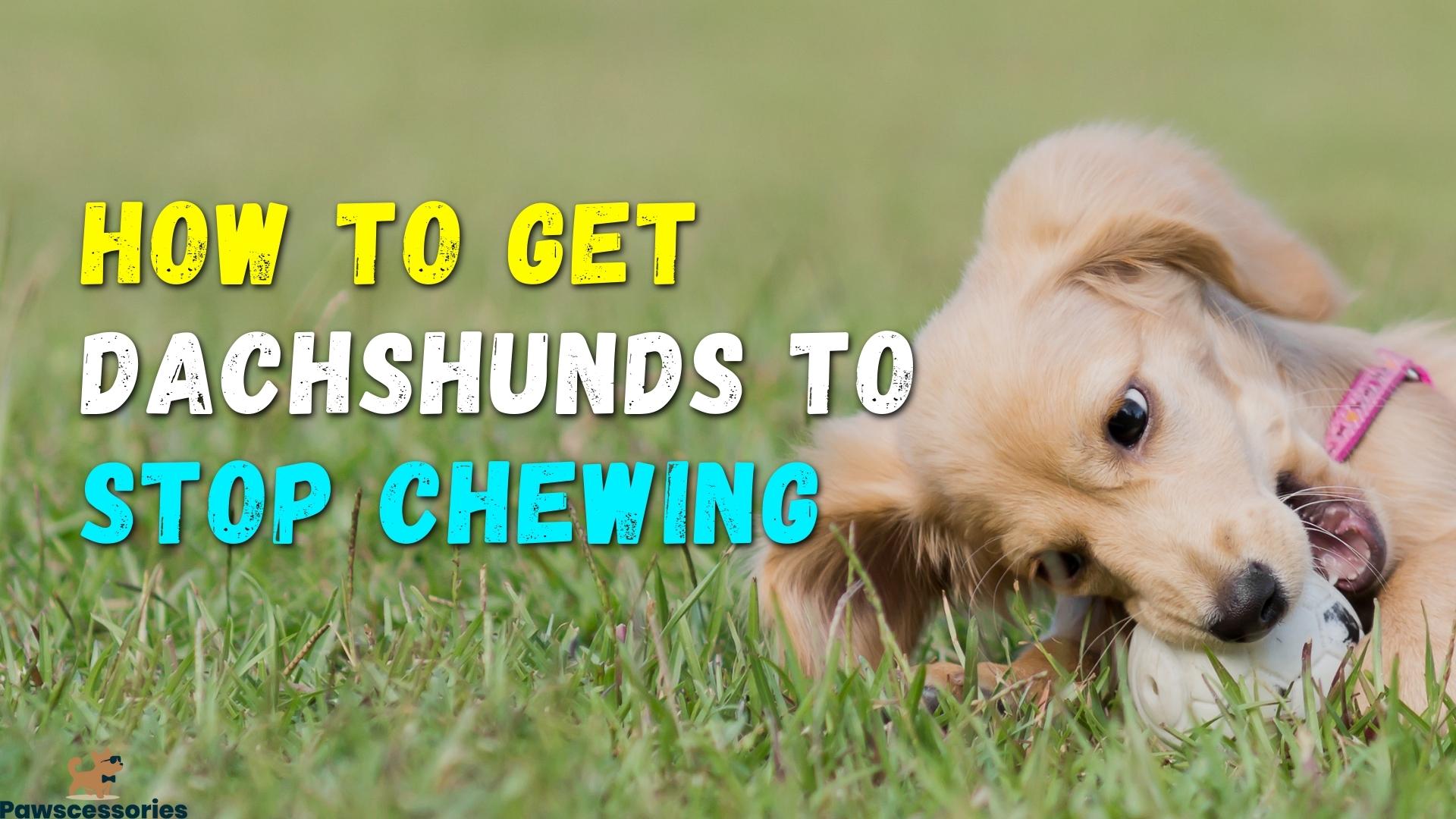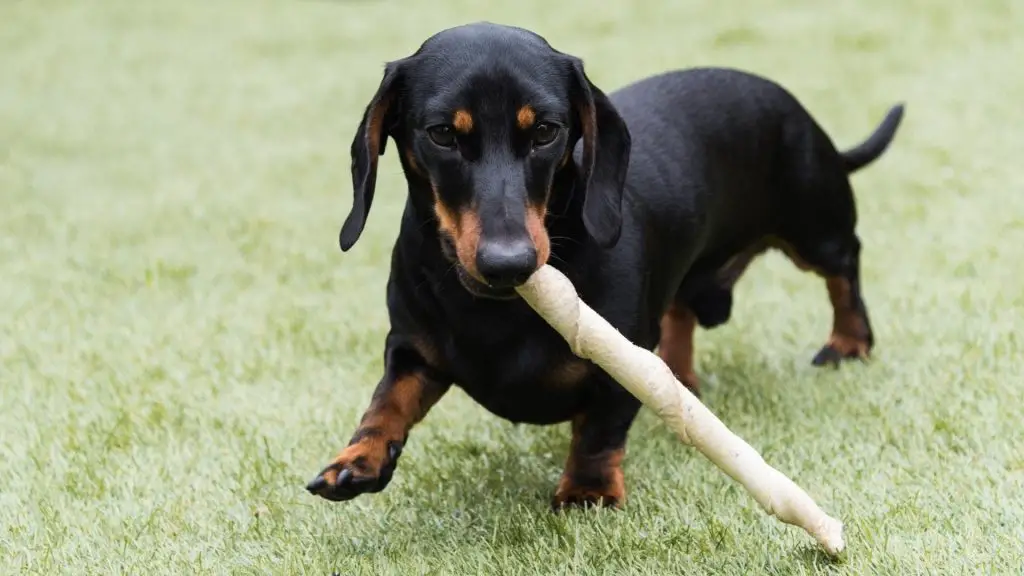Pawscessories is reader-supported. When you buy via links on our site, we may earn an affiliate commission at no cost to you.
Learn more.
When a dachshund chews on anything and everything, to say it’s frustrating is an understatement. Whether it’s your shoes, a table or chair leg, or other valuables, you want nothing more than for it to stop.
First of all, is it normal for dachshunds to chew on everything or is something wrong?
And more importantly how do you get your dachshund to stop chewing? Most dachshunds only chew for 1 of 2 reasons, they’re teething or they’re bored. If they’re teething you need to have other objects prepared that are okay for them to chew on to replace the things you don’t want them to chew on. Boredom chewing means they need more stimulation.
In this post you’ll discover:
- All the reasons why dachshunds start chewing in the first place
- When your dachshunds chewing is something to worry about
- How to get your dachshund to stop chewing (step-by-step)
- And much more
Let’s jump right in.
Table of Contents

Why Do Dachshunds Chew? (The Main Reasons)
There are really two main reasons why dachshunds chew on things you don’t want them to.
The first is teething.
When a dachshund is a young puppy (under 6-8 months) their mouth is going through a lot of reconstruction which causes them pain and discomfort.
One way they deal with this pain is by chewing and gnawing on things.
Whether it’s your shoes, a chair/table leg or anything they can get their paws on that has a texture that feels good on their teeth and gums.
The second reason is boredom.
While this can happen when your dachshund is a young puppy as well, it’s more commonly the reason for an older dachshund to chew.
When dachshunds are bored they often seek out things to do to entertain themselves.
Which unfortunately ends up being chewing on things they shouldn’t be.
These are likely the cause for chewing in 90% of dachshunds but there are a couple other reasons why they might be chewing on everything.
Those are:
- Unintentionally trained to chew – If every time they’ve chewed on something in the past it got them attention, they’ve learned to chew as a way of getting your attention.
- Toothache – Smaller dogs like your dachshund are unfortunately more prone to dental issues. They have the same amount of teeth as bigger dogs but with much less room. Which means there’s a higher chance that they get toothaches or other mouth pain. And chewing helps provide them with a little relief.
- Anxiety – If your dachshund is feeling overly anxious they may chew to help them cope with their strong negative feelings.
- Enjoying the taste/flavor of what they’re chewing on – While you might think a dirty shoe is one of the last things you’d consider tasty, your dachshund may disagree. And if they’ve found out they enjoy the taste of something it’ll unfortunately be a more challenging habit to break.
How To Stop Dachshund Chewing (6 Tips)

Replacement Chews
When your dachshund is a puppy and in their teething phase, it’s less about stopping them from chewing and more about showing them what’s okay to chew.
Teething is a completely normal part of being a puppy and should be expected.
But that doesn’t mean you want to let them chew on anything and everything as that can become costly quite quickly.
Which is why it’s important to provide your dachshund pup with designed things to chew on.
Things like a cold cloth, hard bone, and a medium hardness toy/item.
When your pup is in a ‘I want to chew on everything’ mood, simply give them one of these things and praise them for chewing on them.
Which brings me to the next tip.
Reward Heavily When They Do The Right Thing
When they chew on the items you want them to chew on, go wild with praise!
Make them feel special and especially loved when they chew on these things.
But on the flip side, when they chew on things they shouldn’t, don’t unintentionally reward them with attention.
Many people accidentally ‘reward’ their dachshund when they catch them chewing on something they shouldn’t be.
They do this by yelling at them, picking them up or playing with them to get them to stop.
While this seems like the most logical thing to do, it’s unfortunately training them to chew on these things to get your attention.
Which is why redirecting their attention is the best thing to do instead.
Redirect Their Attention

Ideally you want to do this by getting their attention without touching them.
This corrects the behavior by them choosing to stop rather than being forced to.
How you can do this is by snapping (if you have a loud enough snap) or clapping your hands together.
This way you get their attention on you as opposed to what they were just chewing on.
Next would be to show them the item (cloth, bone, etc.) you want them to chew on and call them over to you.
Then you’d want to reward them heavily for looking at you, stopping, coming over and chewing on the right thing.
This will take many repetitions before it’s completely corrected.
But, if you stay consistent with it, it can be just what your pup needs to learn how to stop chewing on things you don’t want them to.
Limit Access
One of the biggest mistakes owners make with their puppy is giving them too much freedom too early.
They see their pup is behaving well so they let them have free range of the house.
But what ends up happening is they end up getting into things they’re not supposed to and start chewing on anything they feel like.
Even if they’ve had a good couple days of behaving or even a week, you don’t want to give them too much freedom too early.
This gives them the opportunity to create bad habits when you’re not around to correct their behavior.
Which makes things much more difficult to train out of them.
No matter the age of your dachshund, if they have a chewing problem you’ll want to limit how much open access they have.
If you’re not able to pay close attention to them this is where crate training becomes very valuable.
For the times where you have to focus on something else, you’ll want to be able to put them in their crate so they don’t chew on anything while you’re not looking.
Tether Them To You
Some dog trainers will go as far as tethering their puppy to them to ensure they don’t chew on things they shouldn’t be.
Which is simply tying their leash to a belt loop on your pants so they can’t be anymore than 6 feet away from you at any given time.
While this may seem a little excessive, it can be very helpful in ensuring your pup doesn’t get into anything they’re not supposed to.
At the very least you could put their leash on and just carry it around with you or loop it around your chair leg so they have to stay close by.
This way you can keep a better eye on them and correct their chewing behavior as it’s happening.
More Stimulation

Whether it’s more physical stimulation through walks or playing fetch, or mental stimulation from puzzle toys or training, more stimulation can really help with a dachshund’s chewing.
If they’re not getting enough exercise or stimulation in general during the day, they may start chewing on things as a way to relieve boredom.
Often chewing a result of them not getting the necessary attention they need throughout the day.
If they were getting sufficient exercise, play time, and challenged mentally through puzzle toys or training they wouldn’t have the energy to be destructive.
Final Thoughts
Dachshunds are notorious for being difficult to train and having a mind of their own.
But with the right amount of patience and consistency, you can train them not to chew on things they’re not supposed to.
The key is to find what works best for you and your pup and stick with it.
Whether that’s keeping a close eye on them, crate training, tethering them to you, or providing more stimulation throughout the day.
If you’re consistent with whatever method you choose, you’ll see results in no time.
Other posts you might find interesting:
12 Best Dog Beds for Dachshunds
Dachshund Pregnancy: Symptoms & Stages Week By Week
